D Link 2002080002-2 802.11 a/b/g PCI Adapter User Manual dwlag520 manual 0403
D Link Corporation 802.11 a/b/g PCI Adapter dwlag520 manual 0403
D Link >
Contents
User Manual

D-Link DWL-AG520
2.4/5GHz Wireless PCI Adapter
Manual
Rev. 0200402
Building Networks for People
2
Contents
Package Contents .................................................... 3
Introduction............................................................... 4
Wireless Basics ........................................................ 6
Getting Started.......................................................... 8
Using the Configuration Utility ................................ 13
Networking Basics .................................................. 18
Technical Specifications.......................................... 31
Limited Warranty and Registration ......................... 33
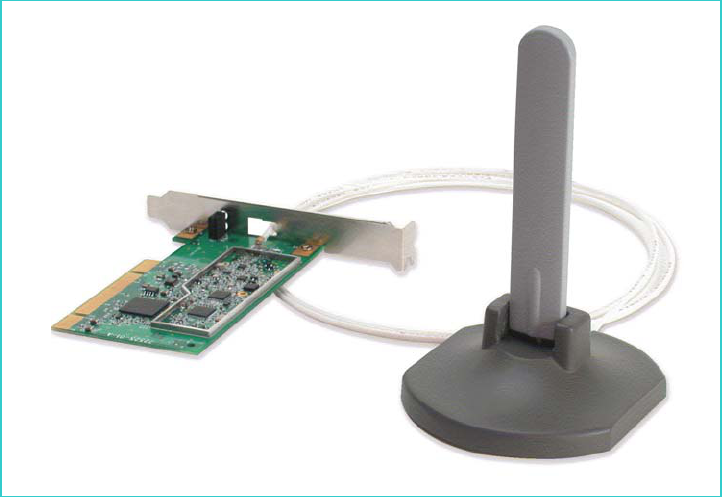
Package Contents
Contents of Package:
• D-Link DWL-AG520 2.4/5GHz Wireless PCI Adapter
• Manual and Drivers on CD
• Quick Installation Guide (printed)
If any of the above items are missing, please contact your reseller.
System Requirements:
• A desktop computer with an available 32-bit PCI Card slot
• Windows XP, Windows 2000, Windows ME, or Windows 98 SE
• At least 32 MB of memory and a 300 MHz processor or higher
4
Introduction
The D-Link DWL-AG520 Wireless PCI Adapter is an advanced IEEE
802.11a/b/g compatible, high performance, wireless adapter that supports
data transfer speeds of up to 108 Mbps in Turbo Mode.
It is an ideal way to connect your laptop computer to a Wireless Local Area
Network (WLAN.) After completing the steps outlined in the Quick Install
Guide (included in your package) you will have the ability to share
information and resources, such as files and printers, and take full
advantage of a “connected” environment for work or play! Please take a
look at our Getting Started section in this manual. You will see several
options for setting up a network using the DWL-AG520.
The DWL-AG520 comes with software drivers for the most popular Microsoft
Windows operating systems and can be integrated into a larger network,
running Windows XP, Windows 2000, Windows ME, Windows 98SE, in
either Ad Hoc mode (without an Access Point) or Infrastructure mode (with
an Access Point.)
This manual provides a quick introduction to wireless technology and its
application as it relates to networking. Take a moment to read through this
manual and get acquainted with wireless technology.
Product Features
• Adheres to 802.11a/b/g standard in providing high data wireless
transfer rates of up to 54 Mbps. Capable of providing data rates of
up to 108 Mbps in Turbo Mode.
• Orthogonal Frequency Division Multiplexing (OFDM) – a new
technique for transmitting high-speed data over a radio wave.
• Supports Wired Equivalent Privacy (WEP) data encryption at
64/128/152-bit encryption with dynamic key exchange for security.
• Supports infrastructure networks via Access Point and Ad-Hoc
networks via peer-to-peer communication.
• Requires an available 32-bit PCI Card slot that is PCI 2.2 compliant.
• User-friendly configuration and diagnostic utilities.
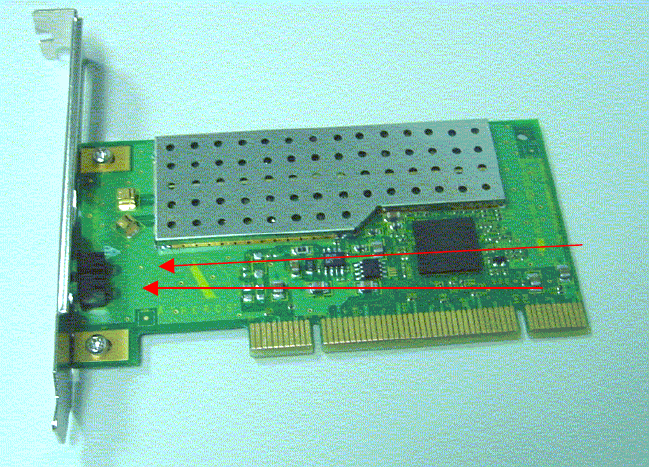
LED
LED stands for light-emitting diode. The DWL-AG520 Wireless PCI
Adapter has two LEDs, as shown below. When the computer is ON, the
adapter is inserted properly, and there is activity on the network, both LEDs
flash in unison. The BOTTOM LED (POWER) flashes to indicate that the
adapter is inserted properly into a computer that is ON. The TOP LED
(Network) flashes to indicate network activity.
TOP
BOTTOM
6
Wireless Basics
D-Link wireless products are based on industry standards to provide easy-
to-use and compatible high-speed wireless connectivity within your home or
business. Strictly adhering to IEEE 802.11a/b/g the D-Link wireless family
of products will allow you to access the data you want, when and where you
want it. No longer will you be limited to one location or forced to run new
wiring through your home or office. You will be able to enjoy the freedom that
wireless networking delivers.
A wireless LAN (WLAN) is a cellular computer network that transmits and
receives data with radio signals instead of wires. Wireless LANs are used
increasingly in both home and office environments. Innovative ways to utilize
WLAN technology are helping people to work and communicate more
efficiently. Increased mobility and the absence of cabling and other fixed
infrastructure has proven to be beneficial for many users.
Wireless users can use the same network applications they use on an
Ethernet LAN. Wireless adapter cards used on laptop and desktop systems,
support the same protocols as Ethernet adapter cards. For most users, there
is no noticeable functional difference between a wired Ethernet desktop
computer and a wireless computer equipped with a wireless adapter other
than the added benefit of the ability to roam within the wireless-cell. Under
many circumstances, it may be desirable for mobile network devices to link
to a conventional Ethernet LAN in order to use servers, printers or an
Internet connection supplied through the wired LAN. A Wireless Access
Point (AP) is a device used to provide this link.
People use wireless LAN technology for many different purposes.
Mobility - Productivity increases when people have access to data in any
location within the operating range of the WLAN. Ad-hoc management
decisions based on real-time information can significantly improve worker
efficiency.
Low Implementation Costs - WLANs are easy to set up, manage, change
and relocate. Networks that frequently change, both physically and logically,
can benefit from WLANs ease of implementation. WLANs can operate in
locations where installation of wiring may be impractical. Furthermore, IEEE
standardization mandates interoperability of all WLAN devices that conform
to the 802.11a/b/g set of standards.
Installation Flexibility - Wireless technology allows the network to go where
wires cannot go.
Installation Considerations
Designed to go up to 1650 feet (~500 meters), D-Link DWL-AG520 lets you
access your network with your computer from virtually anywhere you want.
Keep in mind, however, that the number and thickness of walls, ceilings or
other objects that the wireless signals must pass thru may limit range.
Typical ranges vary depending on the types of materials and background RF
noise in your home or business. The key to maximizing range is to follow
these basic principles:
1. Keep the number of walls and ceilings between the Access Point and
your receiving device to a minimum - Each wall or ceiling can reduce
your D-Link Wireless product’s range from 3-90 feet (1-30 meters.) For
some businesses or for a large residential home deployment, it may be
beneficial to have more than one access point with overlapping coverage.
2. Be aware of the direct line between Access Points and computers with
wireless adapters - A wall that is 1.5 feet thick (.5 meters), at a 45-
degree angle appears to be almost 3 feet (1 meter) thick. At a 2-degree
angle it looks over 42 feet (14 meters) thick! Try to make sure that the
Access Points and Adapters are positioned so that the signal will travel
straight through a wall or ceiling for better reception.
3. Building Materials make a difference - A solid metal door or aluminum
studs may have a negative effect on range. Try to position Access Points,
and computers with wireless adapters so that the signal passes through
drywall or open doorways and not other materials.
4. Make sure that the antenna is positioned for best reception by using the
software signal strength tools included with your product.
5. Keep your product away (at least 3-6 feet or 1-2 meters) from electrical
devices or appliances that generate extreme RF noise.
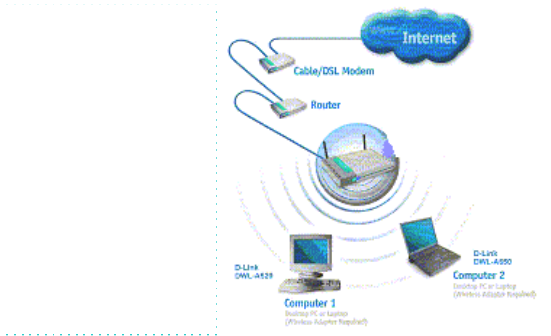
8
Getting Started
To begin, select the type of wireless network you will be building.
We will discuss the following types of networks in this section:
1. A Home Internet Network
with A Residential Gateway/Router
2. A Home Internet Network with Multiple IP Addresses
3. An Ad Hoc Network
4. An Ad Hoc Network with Internet Sharing
Please select, from the four types of networks described above, the type of
network that is appropriate for your needs. Please follow the instructions in
the corresponding section that follows.
1. A Home Internet Network with A Residential Gateway/Router
(Network administrators with Dynamic IPs can also follow these instructions.)
If you have two or more computers (laptops or desktops) and want to share
files, printers, and Internet access using a DHCP-capable Residential
Gateway/Router – or - if you want to connect to an Ethernet network that
uses Dynamic (DHCP) IP addresses, then follow the instructions on the next
page. When it is complete, your network may look similar to this:
1. A Home Internet Network with A Residential Gateway/Router
This type of installation requires that you provide a dynamic IP address for
each computer on your network. You will need a DHCP-capable Residential
Gateway/Router for your network.
DHCP stands for
Dynamic Host
Configuration Protocol.
It is a protocol for
assigning dynamic IP
addresses
“automatically.” With a
DHCP-capable
gateway, there is no
need to manually
assign an IP address.
To complete the installation, please follow these steps:
1. Connect the Router/Gateway (for example, the D-Link DI-704P) to
a Broadband connection, Connect the 802.11a/b/g Access Point to
the router.
2. Install the D-Link DWL-AG520 Wireless PCI Adapter into a
desktop computer on your wireless network. (You can also install the
Wireless Cardbus Adapter into a laptop computer. Please refer to
the Quick Install Guide included with each product.)
3. Check the Device Manager to confirm that the wireless adapter is
installed correctly. Please refer to the Networking Basics section in
this manual entitled: Checking the Installation of the Drivers for
the Wireless Adapter.
4. By default, the wireless adapter is set to obtain a Dynamic IP
Address. If you are having difficulty connecting, check to make sure
that the IP Address of the wireless adapter is within the IP address
range of your network. Please refer to the Networking Basics
section in this manual entitled: Checking The IP Address.
5. Learn to share printers and files. Please refer to the Networking
Basics section in this manual entitled: Adding and Sharing Printers
in Windows XP.
2. A Home Internet Network with Multiple IP Addresses
(Network administrators with Static IPs can also follow these instructions.)
If you have two or more computers (laptops or desktops) and want to share
files, printers, and Internet access using multiple IP addresses that you have
purchased from your Internet Service Provider -or- you want to connect to
an Ethernet network that uses Static IP Addresses, then follow the
instructions on the next page. When you have completed your network, it
should look similar to this:
Please note that this type of installation requires that your ISP (Internet
Service Provider) provides you a static IP address for each computer and
the Access Point on your network. Please refer to the manual that came
with your Access Point to determine its configuration.
Please follow these steps to complete the installation:
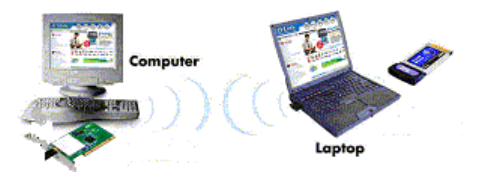
10
1. Connect the Wireless Access Point is shown in the example) to a
Broadband connection (i.e., a Cable modem such as the cable
modem.)
2. Install the DWL-AG520 Wireless PCI Adapter into a desktop
computer on your wireless network. (You can also install the
Wireless Cardbus Adapter into a laptop computer. Please refer to
the Quick Install Guide included with each product.)
3. Check the Device Manager to confirm that the wireless adapter is
installed correctly. Please refer to the Networking Basics section in
this manual entitled: Checking the Installation of the Drivers for
the Wireless Adapter.
4. Set the Static IP Address of the wireless adapters. Please refer to
the Networking Basics section in this manual entitled: Assigning
an IP Address.
5. Learn to share printers and files. Please refer to the Networking
Basics section in this manual entitled: Adding and Sharing Printers
6. in Windows XP.
3. An Ad Hoc Network
If you have two or more computers (desktops or laptops) and want to share
files and printers, but no Internet connection, please complete the following
instructions. When your Ad Hoc network is complete it may look similar to
this:
(Requirements: Wireless network adapters -for example)
To complete this installation, please follow these steps:
1. Install the D-Link DWL-AG520 Wireless PCI Adapter into a desktop
computer on your wireless network. (You can also install the
Wireless Cardbus Adapter into a laptop computer. Please refer to
the Quick Install Guide included with each product.)
2. Set the Static IP Address of the wireless adapters. Please refer to
the Networking Basics section in this manual entitled: Assigning
an IP Address.
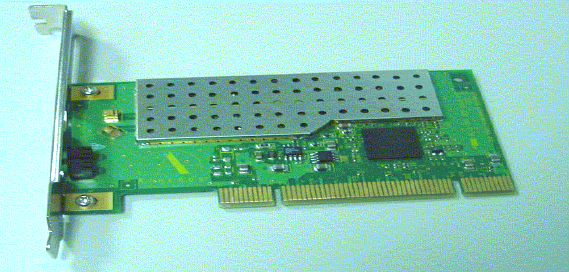
Note: The IP Address for all computers must be in the same IP Address range, and
the Subnet Mask must be the same for all computers on your network. For example:
If the first computer is assigned an IP Address of 192.168.0.2 with a Subnet Mask of
255.255.255.0, then the second computer can be assigned an IP Address of
192.168.0.3 with a Subnet Mask of 255.255.255.0, etc.
3. Check the Device Manager to confirm that the wireless adapter is
installed correctly. Please refer to the Networking Basics section in
this manual entitled: Checking the Installation of the Drivers for
the Wireless Adapter.
4. Check the Wireless Configuration for each wireless adapter.
Please refer to the Networking Basics section in this manual
entitled: Checking the Wireless Configuration.
5. Learn to share printers and files. Please refer to the Networking
Basics section in this manual entitled: Adding and Sharing Printers
in Windows XP.
4. An Ad Hoc Network with Internet Sharing
If you have two or more computers (desktops or laptops) and want to share
files, printers, and Internet access using one computer or laptop as an
Internet Server, then follow the instructions below. When you have
completed your network, it should look similar to this:
If the Internet Sharing Software will be installed on the same computer into
which you are installing this wireless network adapter, then follow these
steps:
1. Install the D-Link DWL-AG520 Wireless PCI Adapter (please refer
to the Quick Install Guide.)
2. Check the Device Manager to confirm that your adapter is installed
correctly. Please refer to the Networking Basics section in this
12
manual entitled: Checking the Installation of the Drivers for the
Wireless Adapter.
3. Install your Internet Sharing Software
4. If required by the ICS software, set the static IP Address for the
wireless adapter. Please refer to the Networking Basics section in
this manual entitled: Assigning an IP Address.
5. Learn to share printers and files. Please refer to the Networking
Basics section in this manual entitled: Adding and Sharing Printers
If the Internet Sharing Software will be installed on a computer other than
the one in which you are installing the D-Link DWL-AG520 Wireless PCI
Adapter, then follow these steps:
1. Install the D-Link DWL-AG520 Wireless PCI Adapter into the
computer (please refer to the Quick Install Guide.)
2. Check the IP Address for the wireless adapter. Please make
certain that all the computers on your network are in the same IP
Address range. Please refer to the Networking Basics section in
this manual entitled: Checking your IP Address.
Note: By default, the wireless adapter is set to obtain a Dynamic IP
Address, automatically.
3. Learn to share printers and files. Please refer to the Networking
Basics section in this manual entitled: Adding and Sharing
Printers in Windows XP.
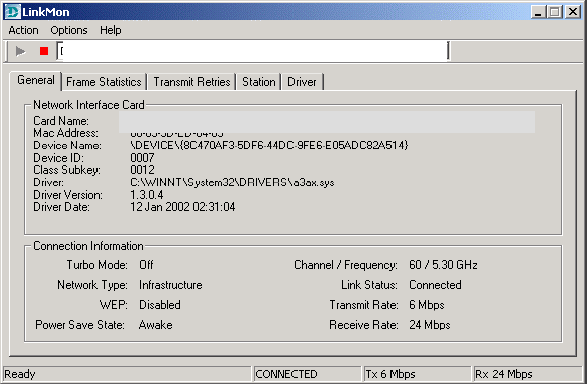
Using the Configuration Utility
The Configuration Utility program for the DWL-AG520 is called LinkMon.
Please refer to the Quick Install Guide that came with the DWL-AG520 for
instructions on how to install LinkMon on your computer. Once you have
installed LinkMon (the configuration utility), you can read this section of the
manual to find out how to monitor and configure your DWL-AG520 adapter
using LinkMon. There are five tabs in the LinkMon Configuration Utility
program. In this section we will describe the uses for each tab in the
Configuration Utility window.
To access LinkMon once it has been installed, just double-click on the
LinkMon icon in the taskbar.
Under the General Tab you will find general information about the program
and its operations.
General Tab
Under the Frame Statistics Tab you will find statistical information showing
the number of frames being sent and received, retry count on frames sent,
frame checksum error counts for received frames, and receive signal
strength indicator (RSSI) information.
D-Link DWL-AG520 802.11a/b/g Wireless PCI Adapter
D-Link DWL-AG520 802.11a/b/g Wireless PCI Adapter
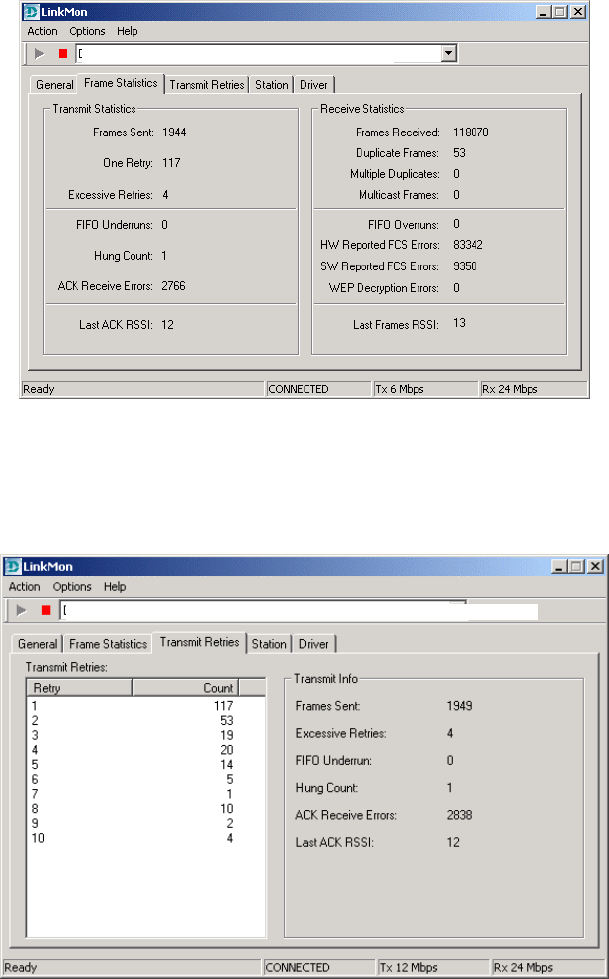
14
Frame Statistics Tab
Under the Transmit Retries Tab you will find detailed transmit retry
statistical information for transmitted frames.
Transmit Retries Tab
D-Link DWL-AG520 802.11a/b/g Wireless PCI Adapter
D-Link DWL-AG520 802.11a/b/g Wireless PCI Adapter
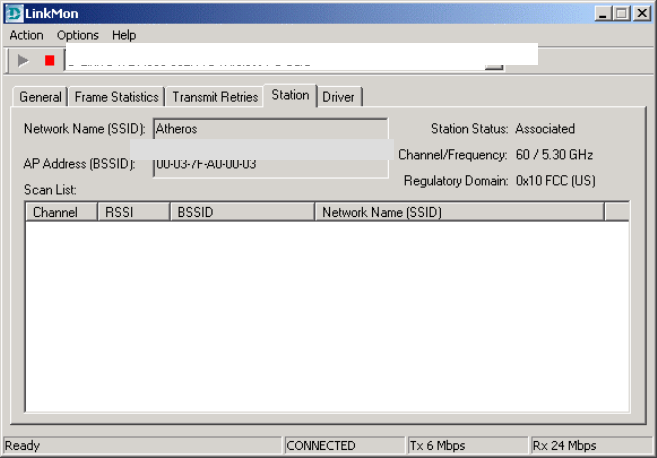
Under the Station Tab you will find detailed BSS information including SSID,
BSSID, association status, operating channel frequency, and information
about scanned APs.
Station Tab
BSS – (Basic Service Set) when one AP is connected to a wired network
and a set of wireless stations, it is a BSS.
SSID – (Service Set Identifier) it is essentially a network name; a name that
identifies a wireless network. All Access Points and all devices attempting to
connect to a specific WLAN (Wireless Local Area Network) must use the
same SSID.
Under the Driver Tab you will find statistical data pertaining to NDIS
(Network Driver Interface Specification) driver operations.
Driver Tab
Default
D-Link DWL-AG520 802.11a/b/g Wireless PCI Adapter
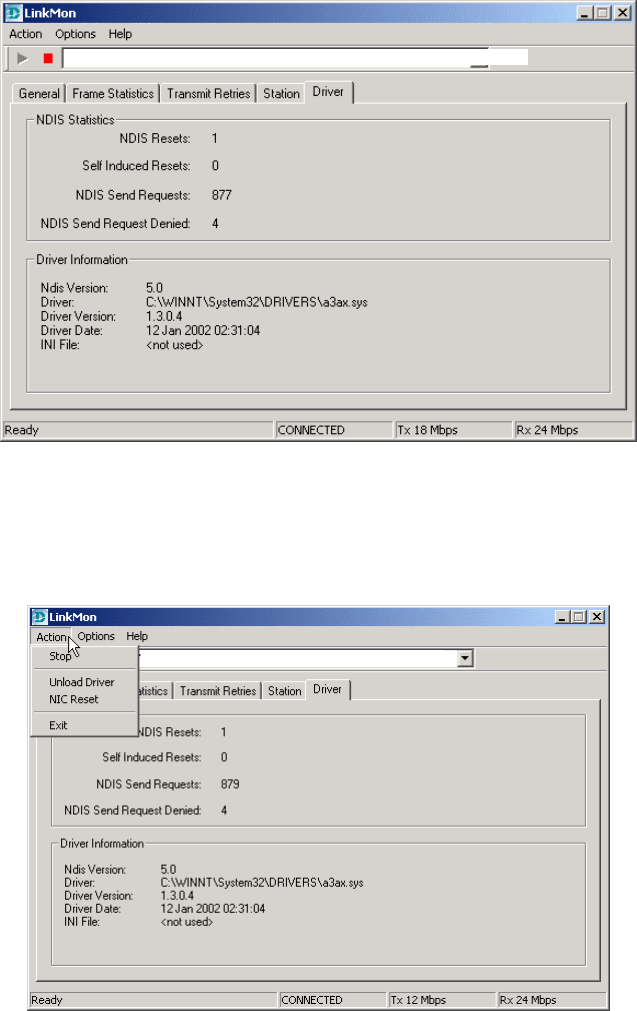
16
The Action menu allows the unloading of the NDIS driver, and the resetting
of the network interface card (NIC.) Note that unloading the driver and
resetting the NIC are options that are available only in Windows XP and
Windows 2000.
D-Link AirXport DWL-AG520 Wireless PCI Adapter
DWL-AG520 802.11a/b/g Wireless PCI Adapter
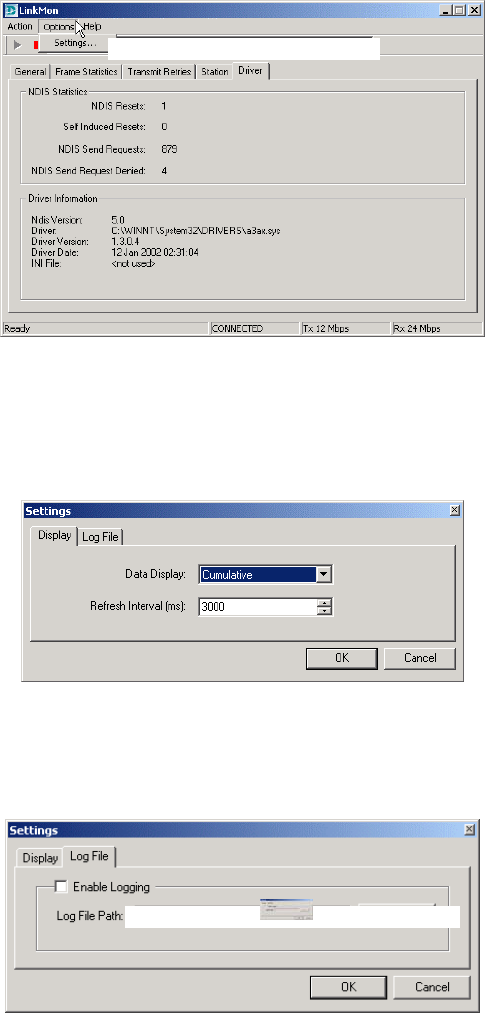
On the Options menu, choose Settings:
Under the Display Tab, you can select the data display modes of
Cumulative, or Relative. Cumulative mode displays statistical data
collected when LinkMon is started. Relative mode displays differences in
the statistical data since the last update of collected data.
Under the Log File Tab, the logging function can be enabled to log to a file
the statistical information collected by the LinkMon utility, for later reference
or post processing by an application such as Microsoft Excel.
Click the Enable Logging click-box to enable LinkMon to write a log file. You must also specify the full
DOS path to the log file, such as C:\Temp\Logfile.
C:
\
Tem
p
\
Lo
g
file
DWL-AG520 802.11a/b/g Wireless PCI Adapter
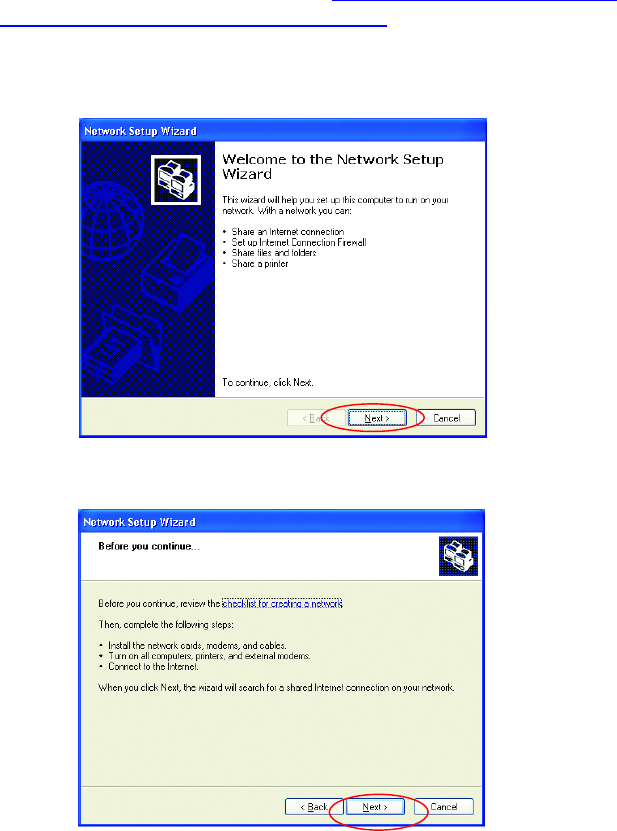
18
Networking Basics
Using the Network Setup Wizard in Windows XP
In this section you will learn how to establish a network at home or work,
using Microsoft Windows XP.
Note: Please refer to websites such as http://www.homenethelp.com
and http://www.microsoft.com/windows2000 for information about
networking computers using Windows 2000, ME or 98.
Go to START>CONTROL PANEL>NETWORK CONNECTIONS
Select Set up a home or small office network
When this screen appears, click Next.
Please follow all the instructions in this window:
Click Next
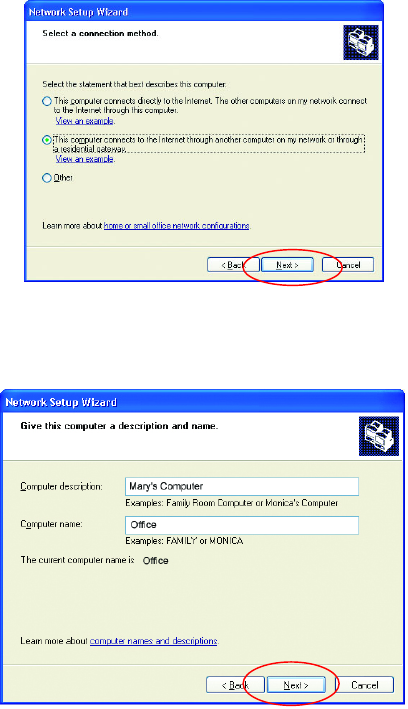
In the following window, select the best description of your computer. If your
computer connects to the internet through a gateway/router, select the
second option as shown.
Click Next
Enter a Computer description and a Computer name (optional.)
Click Next
Enter a Workgroup name. All computers on your network should have the
same Workgroup name.
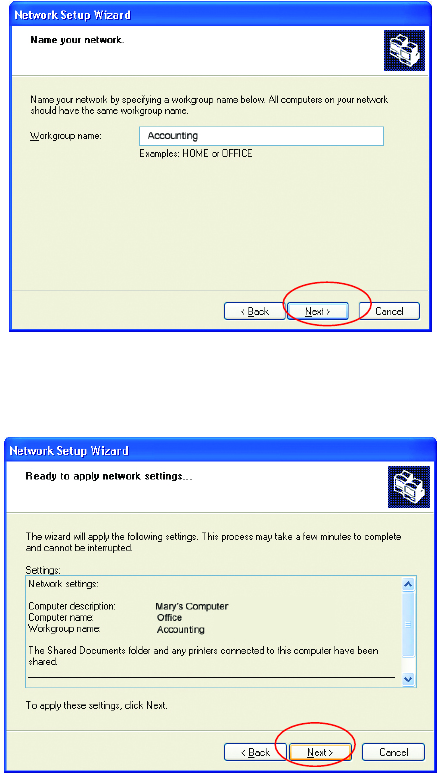
20
Click Next
Please wait while the wizard applies the changes.
When the changes are complete, click Next.
Please wait while the wizard configures the computer.
This may take a few minutes.
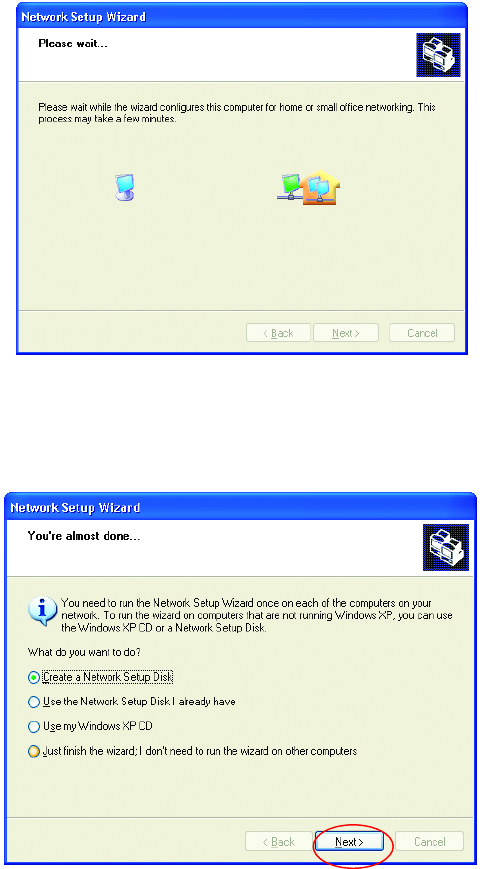
In the window below, select the best option. In this example, Create a
Network Setup Disk has been selected. You will run this disk on each of
the computers on your network. Click Next.
Insert a disk into the Floppy Disk Drive, in this case drive A:
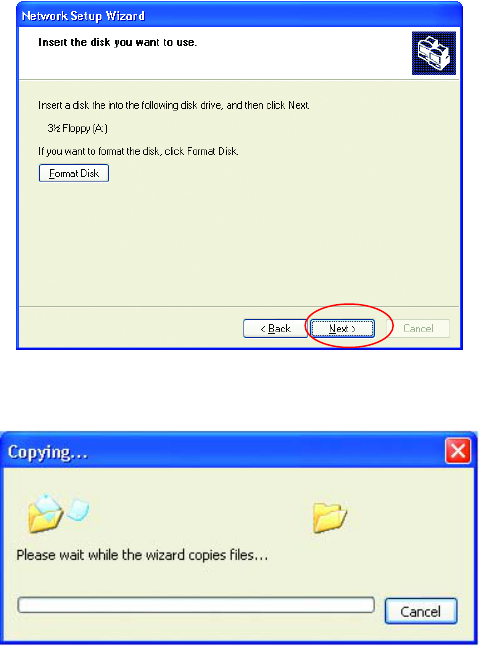
22
Format the disk if you wish, and click Next.
Please wait while the wizard copies the files.
Please read the information under Here’s how in the screen below. After
you complete the Network Setup Wizard you will use the Network Setup
Disk to run the Network Setup Wizard once on each of the computers on
your network. To continue, click Next.
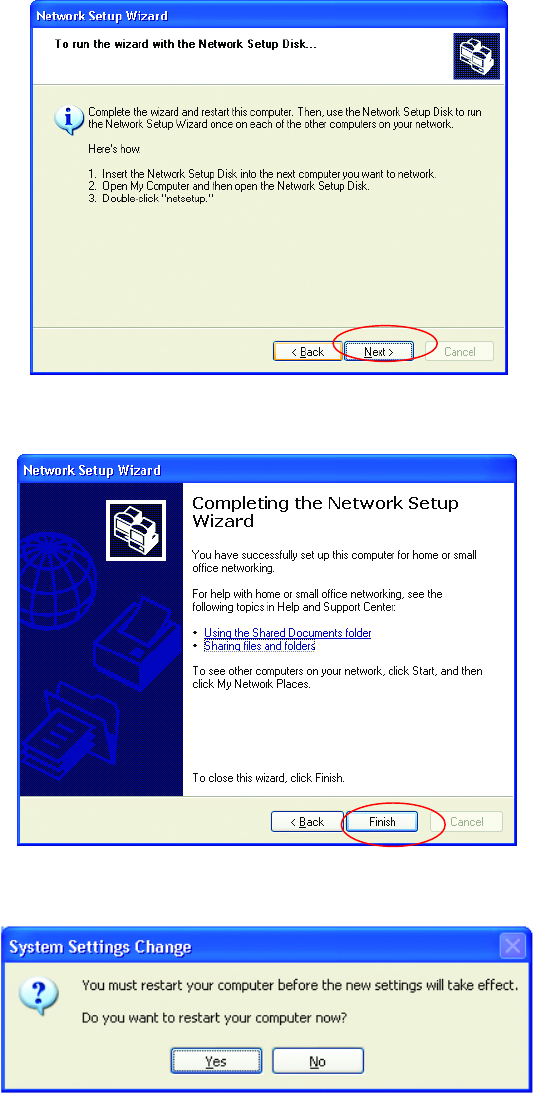
Please read the information on this screen, then click Finish to complete the
Network Setup Wizard.
The new settings will take effect when you restart the computer. Click Yes
to restart the computer.
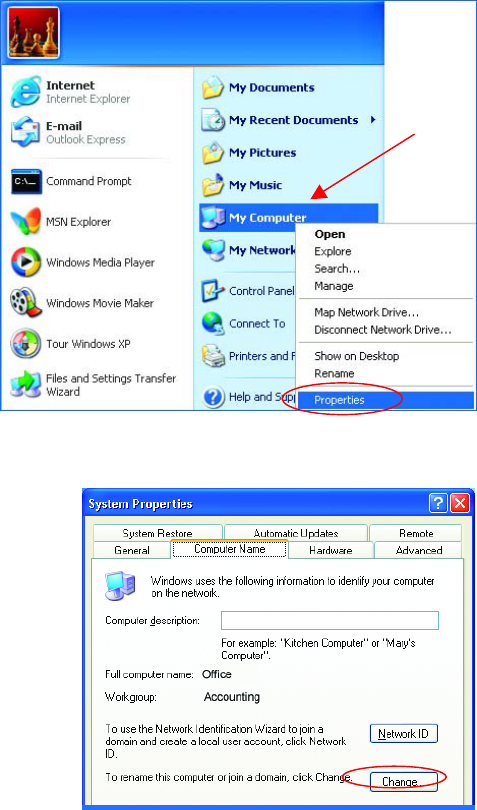
24
You have completed configuring this computer. Next, you will need to run
the Network Setup Disk on all the other computers on your network. After
running the Network Setup Disk on all your computers, your new wireless
network will be ready to use.
Naming your Computer
Naming your computer is optional. If you would like to name your computer
please follow these directions:
In Windows XP:
• Click Start (in the
lower left corner of
the screen)
• Right-click on My
Computer
• Select Properties
and Click
• Select the
Computer Name
Tab in the System
Properties window.
You may enter a
Computer description if
you wish, this field is
optional.
To rename the computer
and join a domain,
• Click Change
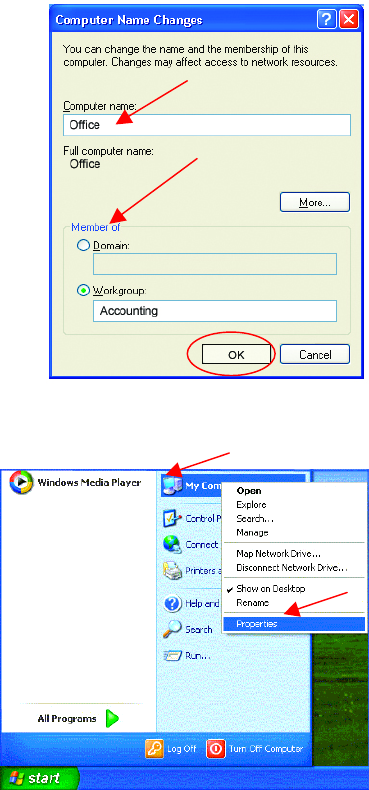
Checking the Installation of the Drivers for the Wireless Adapter
• In this window, enter
the Computer
name.
• Select Workgroup
and enter the name
of the Workgroup.
• All computers on
your network must
have the same
Workgroup name.
• Click OK
• Go to Start
• Right-click
on My
Computer
• Click
Properties
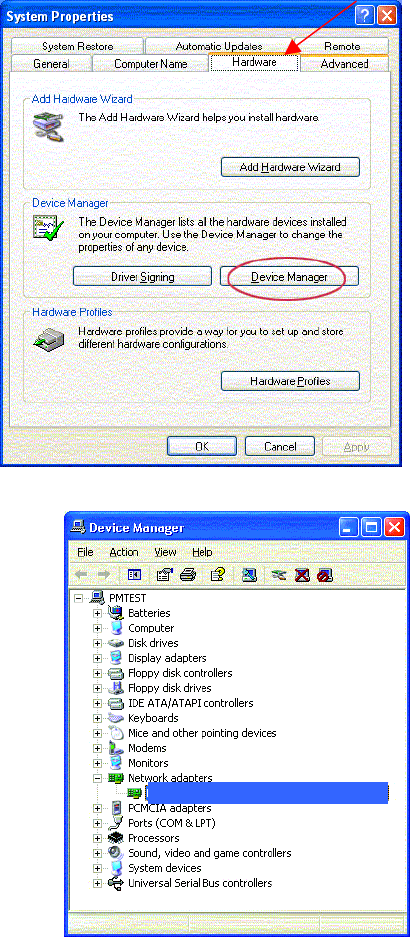
26
• Select the Hardware Tab
• Click Device Manager
• Click on Network
Adapters
• Right-click on D-Link
DWL-AG520 Wireless PCI
Adapter
• Select Properties to check
that the drivers are
installed properly. D-Link AirPro DWL-AG520 Wireless PCI Adapter
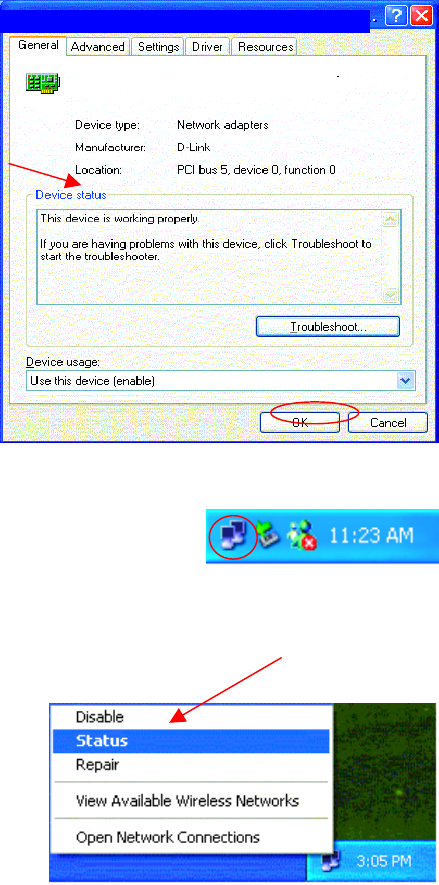
Checking the Installation of the Drivers for the Wireless Adapter
Checking the Wireless Configuration
Checking the IP Address in Windows XP
The following window will display
• Click the Support tab.
• Look under Device
Status
to check that the
device is working
properly.
• Click OK
• Right-click on the
Networking Icon in
the task bar
• Click on Status
• Double-click on the Networking
Icon in the taskbar.
D-Link AorXProt DWL-AG520 Wireless PCI Adapter
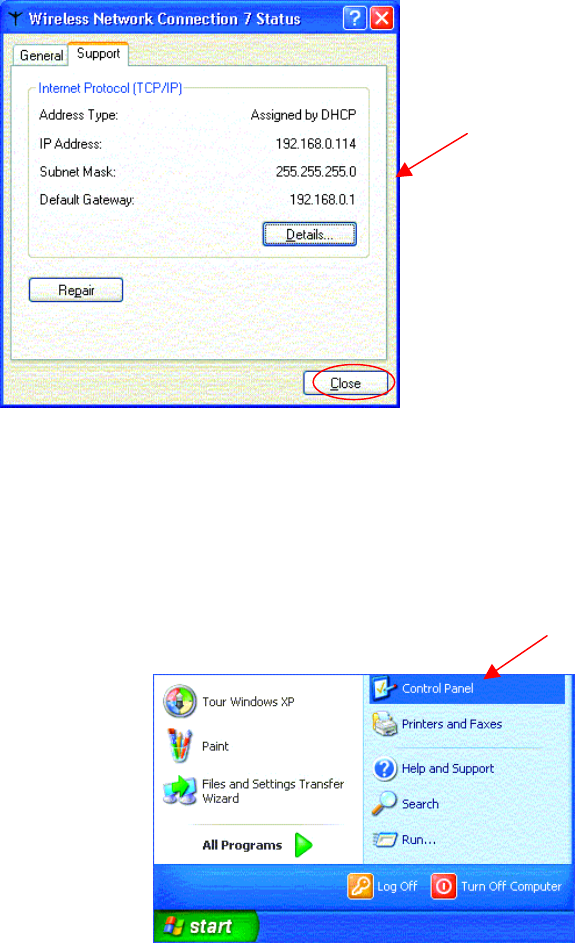
28
• Click Close
Assigning a Static IP Address
Note: Residential Gateways/Broadband Routers will automatically assign IP
Addresses to the computers on the network, using DHCP (Dynamic Host
Configuration Protocol) technology. If you are using a DHCP-capable
Gateway/Router you will not need to assign Static IP Addresses.
If you are not using a DHCP capable Gateway/Router, or you need to assign a
Static IP Address, please follow these instructions:
• Go to Start
• Double-click on
Control Panel
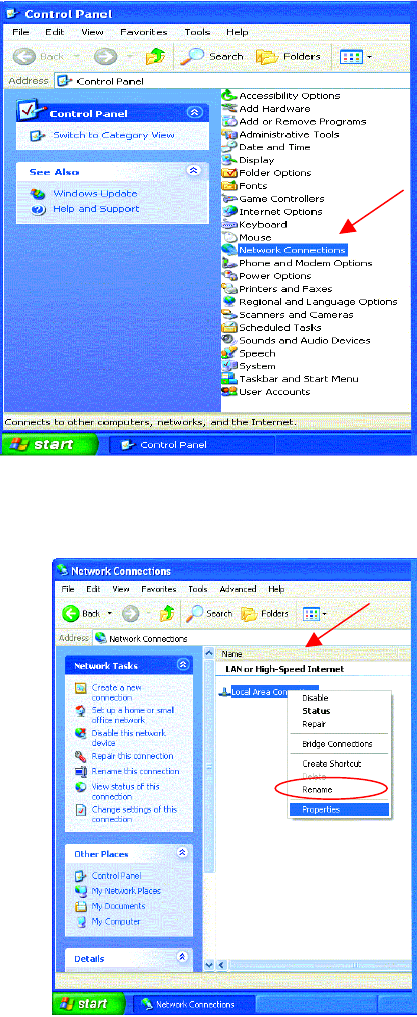
Assigning a Static IP Address
• Double-click on
Network Connections
• Right-click on Local
Area Connections.
• Double-click
Properties
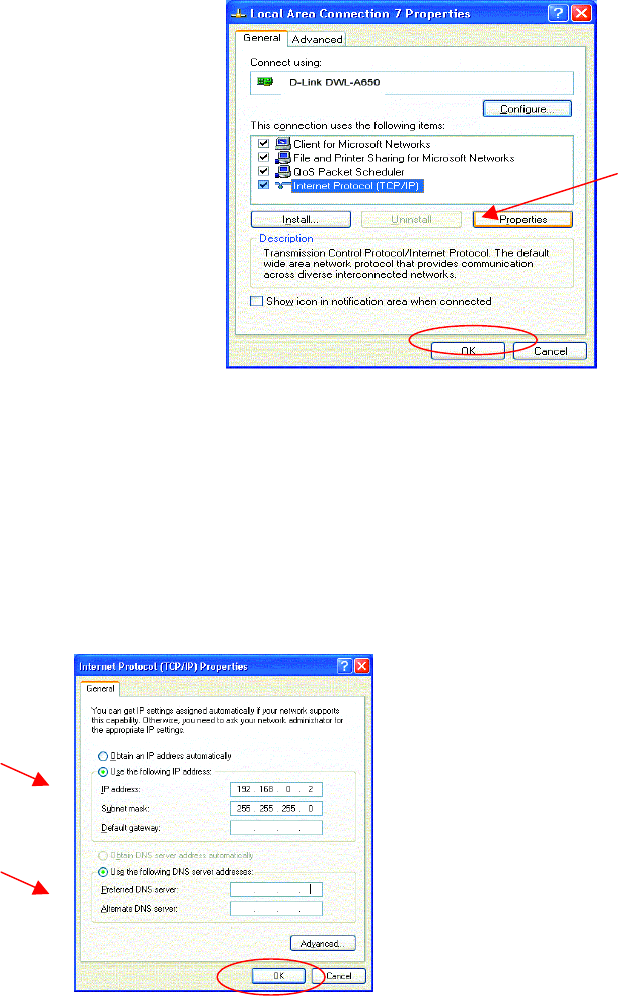
30
Assigning a Static IP Address
• Select Use the following IP address
in the Internet Protocol (TCP/IP) Properties window,
• Input your IP address and subnet mask. (The IP Addresses on your
network must be within the same range. For example, if one computer
has an IP Address of 192.168.0.2, the other computers should have IP
Addresses that are sequential, like 192.168.0.3 and 192.168.0.4. The
subnet mask must be the same for all the computers on the network.)
• Input your DNS server addresses.
• Click OK
You have completed the assignment of a Static IP Address. (You do not need to
assign a Static IP Address if you have a DHCP-capable Gateway/Router.)
• Highlight Internet
Protocol (TCP/IP)
• Click Properties
D-Link AirPro DWL-AG520 Wireless PCI Adapter
Technical Specifications
Standards
• IEEE 802.11a/b/g
Adapter Type
• PCI 2.2 compliant
• PCI 32-bit interface
Supported OS
• Windows XP
• Windows 2000
• Windows ME
• Windows 98SE
Data Security
• 64, 128, 154-bit WEP (Wired Equivalent Privacy) Encryption
Media Access Control
• CSMA/CA
Diagnostic LED
• Power
• Link
Current Consumption
• Sleep mode - <40mW
• Transmit mode - 1650mW
• Receive mode – 1250mW
Operating Voltage
• 3.3V± -10%
Network Architecture
• Ad-Hoc Mode (Peer-to-Peer without Access Point)
• Infrastructure Mode (Communications to wired networks via
Access Points with Roaming)
Antenna Type
• Integrated dual diversity antennas with 5 dBi gain
MBTF (Mean Time Between Failure)
• 30,000 hours
Physical Dimensions
• L ~ 5.24 inches (133 mm)
• W ~ 4.76 inches (121 mm)
• H ~ 0.71 inches (18mm)
Temperature
• Operating: 0ºC to 60ºC (32ºF to 140ºF)
• Storing: -20ºC to 85ºC (-4ºF to 185ºF)
32
Humidity:
• 5%-95%, non-condensing
Emissions:
• FCC part 15b
• UL1950-3
•
You can find the most recent software and user documentation on the D-Link
website.
D-Link provides free technical support for customers within the United States
for the duration of the warranty period on this product.
U.S. customers can contact D-Link technical support through our web site,
or by phone.
D-Link Technical Support over the Telephone:
(800) 758-5489
24 hours a day, seven days a week.
D-Link Technical Support over the Internet:
http://support.dlink.com
When contacting technical support, please provide the following information:
• Serial number of the unit
• Model number or product name
• Software type and version number

Limited Warranty and Registration
D-Link Systems, Inc. (“D-Link”) provides this 3-Year warranty for its product only to the person or entity
who originally purchased the product from:
• D-Link or its authorized reseller or distributor.
• Products purchased and delivered with the fifty United States, the District of Columbia, US
Possessions or Protectorates, US Military Installations, addresses with an APO or FPO.
3-Year Limited Hardware Warranty: D-Link warrants that the hardware portion of the D-Link products
described below (“Hardware”) will be free from material defects in workmanship and materials from the
date of original retail purchase of the Hardware, for the period set forth below applicable to the product
type (“Warranty Period”).
3-Year Limited Warranty for the Product(s) is defined as follows
• Hardware (excluding power supplies and fans)
• Spare parts and spare kits Ninety (90) days.
D-Link’s sole obligation shall be to repair or replace the defective Hardware at no charge to the original
owner. Such repair or replacement will be rendered by D-Link at an Authorized D-Link Service Office. The
replacement Hardware need not be new or of an identical make, model or part; D-Link may in its
discretion replace the defective Hardware (or any part thereof) with any reconditioned product that D-Link
reasonably determines is substantially equivalent (or superior) in all material respects to the defective
Hardware. The Warranty Period shall extend for an additional ninety (90) days after any repaired or
replaced Hardware is delivered. If a material defect is incapable of correction, or if D-Link determines in
its sole discretion that it is not practical to repair or replace the defective Hardware, the price paid by the
original purchaser for the defective Hardware will be refunded by D-Link upon return to D-Link of the
defective Hardware. All Hardware (or part thereof) that is replaced by D-Link, or for which the purchase
price is refunded, shall become the property of D-Link upon replacement or refund.
Limited Software Warranty: D-Link warrants that the software portion of the product (“Software”) will
substantially conform to D-Link’s then current functional specifications for the Software, as set forth in the
applicable documentation, from the date of original delivery of the Software for a period of ninety (90)
days (“Warranty Period”), if the Software is properly installed on approved hardware and operated as
contemplated in its documentation. D-Link further warrants that, during the Warranty Period, the magnetic
media on which D-Link delivers the Software will be free of physical defects. D-Link’s sole obligation shall
be to replace the non-conforming Software (or defective media) with software that substantially conforms
to D-Link’s functional specifications for the Software. Except as otherwise agreed by D-Link in writing, the
replacement Software is provided only to the original licensee, and is subject to the terms and conditions
of the license granted by D-Link for the Software. The Warranty Period shall extend for an additional
ninety (90) days after any replacement Software is delivered. If a material non-conformance is incapable
of correction, or if D-Link determines in its sole discretion that it is not practical to replace the non-
conforming Software, the price paid by the original licensee for the non-conforming Software will be
refunded by D-Link; provided that the non-conforming Software (and all copies thereof) is first returned to
D-Link. The license granted respecting any Software for which a refund is given automatically terminates.
What You Must Do For Warranty Service:
Registration is conducted via a link on our Web Site (http://www.dlink.com/). Each product purchased
must be individually registered for warranty service within ninety (90) days after it is purchased and/or
licensed.
FAILURE TO PROPERLY TO REGISTER MAY AFFECT THE WARRANTY FOR THIS PRODUCT.
Submitting A Claim. Any claim under this limited warranty must be submitted in writing before the end of
the Warranty Period to an Authorized D-Link Service Office.
• The customer must submit as part of the claim a written description of the Hardware defect or
Software nonconformance in sufficient detail to allow D-Link to confirm the same.
• The original product owner must obtain a Return Material Authorization (RMA) number from the
Authorized D-Link Service Office and, if requested, provide written proof of purchase of the product
(such as a copy of the dated purchase invoice for the product) before the warranty service is provided.
• After an RMA number is issued, the defective product must be packaged securely in the
original or other suitable shipping package to ensure that it will not be damaged in transit, and the
RMA number must be prominently marked on the outside of the package.
• The customer is responsible for all shipping charges to and from D-Link (No CODs allowed).
Products sent COD will become the property of D-Link Systems, Inc. Products should be fully insured
by the customer and shipped to D-Link Systems Inc., 53 Discovery Drive, Irvine CA 92618.
D-Link may reject or return any product that is not packaged and shipped in strict compliance with the
foregoing requirements, or for which an RMA number is not visible from the outside of the package. The
product owner agrees to pay D-Link’s reasonable handling and return shipping charges for any product
34
that is not packaged and shipped in accordance with the foregoing requirements, or that is determined by
D-Link not to be defective or non-conforming.
What Is Not Covered:
This limited warranty provided by D-Link does not cover: Products that have been subjected to abuse,
accident, alteration, modification, tampering, negligence, misuse, faulty installation, lack of reasonable
care, repair or service in any way that is not contemplated in the documentation for the product, or if the
model or serial number has been altered, tampered with, defaced or removed; Initial installation,
installation and removal of the product for repair, and shipping costs; Operational adjustments covered in
the operating manual for the product, and normal maintenance; Damage that occurs in shipment, due to
act of God, failures due to power surge, and cosmetic damage; and Any hardware, software, firmware or
other products or services provided by anyone other than D-Link.
Disclaimer of Other Warranties: EXCEPT FOR THE 3-YEAR LIMITED WARRANTY SPECIFIED HEREIN, THE PRODUCT IS
PROVIDED “AS-IS” WITHOUT ANY WARRANTY OF ANY KIND INCLUDING, WITHOUT LIMITATION, ANY WARRANTY OF
MERCHANTABILITY, FITNESS FOR A PARTICULAR PURPOSE AND NON-INFRINGEMENT. IF ANY IMPLIED WARRANTY CANNOT BE
DISCLAIMED IN ANY TERRITORY WHERE A PRODUCT IS SOLD, THE DURATION OF SUCH IMPLIED WARRANTY SHALL BE
LIMITED TO NINETY (90) DAYS. EXCEPT AS EXPRESSLY COVERED UNDER THE LIMITED WARRANTY PROVIDED HEREIN, THE
ENTIRE RISK AS TO THE QUALITY, SELECTION AND PERFORMANCE OF THE PRODUCT IS WITH THE PURCHASER OF THE
PRODUCT.
Limitation of Liability: TO THE MAXIMUM EXTENT PERMITTED BY LAW, D-LINK IS NOT LIABLE UNDER ANY CONTRACT,
NEGLIGENCE, STRICT LIABILITY OR OTHER LEGAL OR EQUITABLE THEORY FOR ANY LOSS OF USE OF THE PRODUCT,
INCONVENIENCE OR DAMAGES OF ANY CHARACTER, WHETHER DIRECT, SPECIAL, INCIDENTAL OR CONSEQUENTIAL
(INCLUDING, BUT NOT LIMITED TO, DAMAGES FOR LOSS OF GOODWILL, WORK STOPPAGE, COMPUTER FAILURE OR
MALFUNCTION, LOSS OF INFORMATION OR DATA CONTAINED IN, STORED ON, OR INTEGRATED WITH ANY PRODUCT
RETURNED TO D-LINK FOR WARRANTY SERVICE) RESULTING FROM THE USE OF THE PRODUCT, RELATING TO WARRANTY
SERVICE, OR ARISING OUT OF ANY BREACH OF THIS LIMITED WARRANTY, EVEN IF D-LINK HAS BEEN ADVISED OF THE
POSSIBILITY OF SUCH DAMAGES. THE SOLE REMEDY FOR A BREACH OF THE FOREGOING LIMITED WARRANTY IS REPAIR,
REPLACEMENT OR REFUND OF THE DEFECTIVE OR NON-CONFORMING PRODUCT.
GOVERNING LAW: This 3-Year Warranty shall be governed by the laws of the state of California. Some states do not allow exclusion or
limitation of incidental or consequential damages, or limitations on how long an implied warranty lasts, so the foregoing limitations and
exclusions may not apply. This limited
warranty provides specific legal rights and the product owner may also have other rights which vary from state to state.
Trademarks
Copyright® 2002 D-Link Corporation. Contents subject to change without prior notice. D-Link is a registered trademark of D-Link
Corporation/D-Link Systems, Inc. All other trademarks belong to their respective proprietors.
Copyright Statement
No part of this publication may be reproduced in any form or by any means or used to make any derivative such as translation,
transformation, or adaptation without permission from D-Link Corporation/D-Link Systems Inc., as stipulated by the United States Copyright
Act of 1976.
CE Mark Warning
This is a Class B product. In a domestic environment, this product may cause radio interference, in which case the user may be required to
take adequate measures.
FCC Statement
This equipment has been tested and found to comply with the limits for a Class B digital device, pursuant
to part 15 of the FCC Rules. These limits are designed to provide reasonable protection against harmful
interference in a residential installation. This equipment generates, uses and can radiate radio frequency
energy and, if not installed and used in accordance with the instructions, may cause harmful interference
to radio communication. However, there is no guarantee that interference will not occur in a particular
installation. If this equipment does cause harmful interference to radio or television reception, which can
be determined by turning the equipment off and on, the user is encouraged to try to correct the
interference by one or more of the following measures:
• Reorient or relocate the receiving antenna.
• Increase the separation between the equipment and receiver.
• Connect the equipment into an outlet on a circuit different from that to which the receiver is
connected.
• Consult the dealer or an experienced radio/TV technician for help.
Modifications to this device are not authorized, may violate FCC regulation Part 15.407, and will void the
warranty for this product. This device is intended to operate in the frequency band of 5.15 to 5.25 GHz
under all conditions of normal operation. According to FCC 15.407 (e), normal operation of this device is
restricted to indoor use only to reduce any potential harmful interference to co-channel Mobile Satellite
Systems, or radar systems that use 5.25 to 5.35 GHz and 5.65 to 5.85 GHz frequency bands. This
interference could also damage this device.
Registration: Register your D-Link AirXport DWL-AG520 online at http://www.dlink.com/sales/reg
FCC RF Radiation Exposure Statement:
1. This Transmitter must not be co-located or operating in conjunction with any other antenna or
transmitter.
2. This equipment complies with FCC RF radiation exposure limits set forth for an uncontrolled
environment. This equipment should be installed and operated with a minimum distance of 20
centimeters between the radiator and your body.